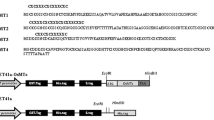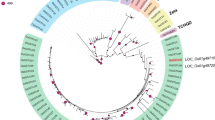Abstract
Metallothioneins (MTs) are low-molecular weight cysteine (Cys)-rich proteins with high metal-binding capacity. Based on the Cys arrangement in their amino acid sequences, plant MTs are categorized into four classes. This study evaluated the ability of genetically engineered Escherichia coli cells, which express four rice MT isoforms as fusion proteins with glutathione-S-transferase (GST), to remove arsenic. As compared with control strain, the expression of GST-OsMT1, GST-OsMT2, GST-OsMT3, and GST-OsMT4 resulted in 8-, 5.6-, 3-, and 1.1-fold-higher As3+ accumulation. The recombinant GST-OsMT isoforms were purified using affinity chromatography and their apo-forms were prepared. The ability of the GST-OsMT2 isoform to bind with As3+ in vitro was also confirmed by ultraviolet (UV) absorption spectra recorded after the reconstitution of apo-proteins with As3+. However, the formation of complexes of other MT isoforms with arsenic was not observed.





Similar content being viewed by others
References
Bae W, Mehra RK, Mulchandani A, Chen W (2001) Genetic engineering of E. coli for enhanced uptake and bioaccumulation of mercury. Appl Environ Microbiol 67:5335–5338
Cobbet C, Goldsbrough P (2002) Phytochelatins and metallothioneins: roles in heavy metal detoxification and homeostasis. Anu Rev Plant Biol 53:159–182
Cullen WR, Reimer KJ (1989) Arsenic speciation in the environment. Chem Rev 89:713–764
Huang X, Sillanpää M, Duo B, Gjessing ET (2008) Water quality in the Tibetan plateau: metal contents of four selected rivers. Environ Pollut 156:270–277
Huang X, Sillanpää M, Gjessing ET, Peräniemi S, Vogt RD (2011) Water quality in the southern Tibetan plateau: chemical evaluation of the Yarlung Tsangpo (Brahmaputra). River Res Appl 27:113–121
Korte NE, Fernando Q (1991) Review of arsenic(III) in groundwater. Crit Rev Environ Control 21:1–39
Kostal J, Yang R, Wu CH, Mulchandani A, Chen W (2004) Enhanced arsenic accumulation in engineered bacterial cells expressing ArsR. Appl Environ Microbiol 70:4582–4587
Matschullat J (2000) Arsenic in the geosphere: a review. Sci Total Environ 249:297–312
Mohammadi Nezhad R, Shahpiri A, Mirlohi A (2013) Discrimination between two rice metallothionein isoforms belonging to type 1 and type 4 in metal-binding ability. Biotechnol Appl Biochem 60:275–282
Nordstrom DK (2002) Worldwide occurrences of arsenic in ground water. Sci 296:2143–2145
Pazirandeh M, Wells BM, Ryan RL (1998) Development of bacterium-based heavy metal biosorbent: enhanced uptake of cadmium and mercury by E. coli expressing a metal binding motif. Appl Environ Microbiol 64:4068–4072
Peryea FJ, Creger TL (1994) Vertical distribution of lead and arsenic in soils contaminated with lead arsenate pesticide residues. Water Air Soil Pollut 78:297–306
Pirzadeh S, Shahpiri A (2016) Functional characterization of a type 2 metallothionein isoform (OsMTI-2b) from rice. Int J Biol Macromol 88:491–496
Robinson NJ, Tommey AM, Kuske C, Jackson PJ (1993) Plant metallothioneins. Biochem J 295:1–10
Ruiz ON, Alvarez D, Gonzales-Ruiz G, Torres C (2011) Characterization of mercury bioremediation by transgenic bacteria expressing metallothionein and polyphosphate kinase. BMC Biotechnol 11:82
Shahpiri A, Soleimanifard I, Asadollahi MA (2015) Functional characterization of a type 3 metallolthionein isoform (OsMTI-3a) from rice. Int J Biol Macromol 73:154–159
Sharma VK, Sohn M (2009) Aquatic arsenic: toxicity, speciation, transformations and remediation. Environ Int 35:743–759
Singh JS, Abhilash PC, Singh HB, Singh RP, Singh DP (2011) Genetically engineered bacteria: an emerging tool for environmental remediation and future research perspectives. Gene 480:1–9
Singh S, Lee W, DaSilva NA, Mulchandani A, Chen W (2008) Enhanced arsenic accumulation by engineered yeast cells expressing Arabidopsis thaliana phytochelatin synthase. Biotechnol Bioeng 99:333–340
Singh S, Mulchandani A, Chen W (2008) Highly selective and rapid arsenic removal by metabolically engineered Escherichia coli cells expressing fucus vesiculosus metallothionein. Appl Environ Microbiol 74:2924–2927
Tchounwou PB, Patlolla AK, Centeno JA (2003) Invited reviews: carcinogenic and systemic health effects associated with arsenic exposure-a critical review. Toxicol Pathol 31:575–588
Toriumi S, Saito T, Hosokawa T, Takahashi Y, Numata T, Kurasaki M (2005) Metal binding ability of metallothionein-3 expressed in Escherichia coli. Basic Clin Toxicol Pharmacol 96:295–301
Yuan T, Luo QF, Hu JY, Ong SL, Ng WJ (2003) A study on arsenic removal from household drinking water. J Environ Sci Health 38:1731–1744
Zarei M, Shahpiri A, Esmaeilnejad-Ahranjani P, Arpanaeil A (2016) Metallothionein-immobilized silica-coated magnetic particles as a novel nanobiohybrid adsorbent for highly efficient removal of cadmium from aqueous solutions. RSC Adv 6:46785–46793
Zhao FJ, McGrath SP, Meharg AA (2010) Arsenic as a food chain contaminant: mechanism of plant uptake and metabolism and mitigation strategies. Annu Rev Plant Biol 61:535–559
Acknowledgements
Iran National Science Foundation is thanked for the financial support (Grant No. 97000792).
Author information
Authors and Affiliations
Corresponding author
Rights and permissions
About this article
Cite this article
Shahpiri, A., Mohammadzadeh, A. Bioaccumulation of Arsenic by Engineered Escherichia coli Cells Expressing Rice Metallothionein Isoforms. Curr Microbiol 75, 1537–1542 (2018). https://doi.org/10.1007/s00284-018-1556-3
Received:
Accepted:
Published:
Issue Date:
DOI: https://doi.org/10.1007/s00284-018-1556-3




